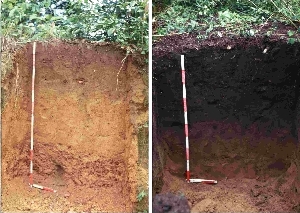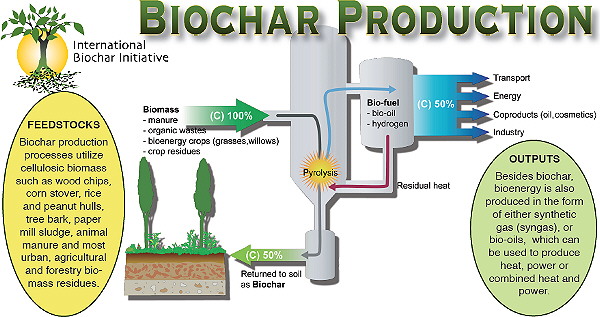
I’m really fascinated with the terra preta/biochar concept. We briefly touched on the subject in our blog post Big Ideas that are Changing the World. Watch the excellent video there for a good overview of the subject.
Terra preta is nothing short of amazing. It’s considered the most fertile soil in the world, and has retained its fertility over thousands of years. Studies have reported positive effects from biochar on crop production in degraded and nutrient–poor soils. Biochar–enhanced soils can indefinitely sustain agricultural production [that means forever!], whereas non-amended soils quickly become depleted of nutrients. Compare terra preta to modern industrial agriculture that gradually depletes soil and pollutes groundwater and food sources with toxic chemicals.

That’s the background story. My personal goal is to do some small scale biochar experiments to improve our garden. Based on a little research, it seems most efforts to recreate the awesome terra preta soil in the Amazon seem based on a cookbook approach – add X, Y and Z and hope it works. So far no one to my knowledge has perfectly replicated what the ancients knew. The secret may lie in creating synergy between the ingredients so the end result is greater than the sum of its individual parts.
Possible ingredients for making terra preta: charcoal, worm compost, worms, effective microorganisms (EM), wood ash, lava ash, leaves, grass clippings, straw, rice hulls, manure, coconut husks and shells and charcoal, bagasse, rice hulls and rice hull ash (convenient source of affordable charcoal), mycorhizzae (a fungus superhero), rock dust, seaweed, fish bones, food scraps, composted weeds, pottery shards and other low cost natural ingredients. And remember, the terra preta doesn’t have to be exactly the same as the stuff in South America. Your plants should take off if you get it 90% right.
Two ingredients that stand out from the rest and seem to play a central role in terra preta:
Charcoal: Biochar or agrichar (biomass turned into charcoal by smoldering) is a key ingredient of terra preta. Charcoal is very porous and so it has lots of surface area to retain water and nutrients. That means reduced irrigation and fertilizer requirements, less nutrient leaching, and higher crop uptake of nutrients. Biochar boosts agricultural production, improves soil structure and pH. Biochar can retain twice as much carbon dioxide than typical soil, and therefore could help mitigate global climate change via carbon sequestration. Burying biochar helps prevent it from getting washed away in the rainy season.
Worms: Following observations and experiments, a research team working in French Guiana hypothesized that the Amazonian earthworm Pontoscolex corethrurus was the main agent of fine powdering and incorporation of charcoal debris to the mineral soil. More details available at Wiki- Biochar.
Image source 2: Energy Realist.com

Black soils have also been found in North America, Russia, Europe, India. I have been making Charcoal for 10 years and adding what I can of the Terra Preta formula to it. Results have been excllent but initially took some time for the micro biology to kick in as we’re surround by close forest on recently cleared land. Pot shards, keritin from tortise shell or hair and fingernails, manure, bones, water plants,land plants, soil and clay, Charcoal and ash, urine. I have also experimented on Davidson plums to compared growth rates. Results were surprising and the effect spreads out from the source of the black soil to the normal soil after a few years. The worms love it and it has grown some giants.
Thanks for the update. I still think about terra preta soil sometimes. One thing I’ve read said high quality topsoil like in North America is different. It’s probably from grasslands that had active grassing of buffalo, etc. and prairie fires. What I’m seeing in our garden is soil development takes a long time and is hard to predict. It’s mostly about getting good soil microbes. At some point they kick in and do the work.
This may be relevant to this topic:
http://www.carboncultures.com
They’re selling the equipment to turn forest logging wastes into a profitable commodity. The process takes place in the forest to reduce shipping and handling. The biochar is sold to local farmers to improve the soil.
For the idiot, what exactly is this?
Sounds like crop(after harvest)/weed burning on top your field… then adding some compost (and/or bury some fish or other hunted prey’s guts/waist meet) and giving it a good turn over with the motorized thing(tiller?).
Had to help my friend do this to their families fields ALL the time growing up…
I’m not sure if anyone understands exactly how terra preta soil was made. There are no written records of the process. Only one place in the world has it as far as I know, so that would rule out farming techniques such as you describe. Scientists are racing to figure this out and I suspect those who unravel the secrets will receive a Nobel prize.
We are in the process of growing nut trees and other edible species to plant on our property in Northern Tasmania. We have been learning everything that we can about our soil, how to amend it and how to give it everything that it needs. I recently went to a series of workshops by the Tamar NRM that highlighted how to work WITH your property rather than in the usual way and learned all about Terra preta and was blown away! Really looking forwards to your future posts and to you sharing how you are doing it all…precious work that needs to be shared. Cheers in anticipation :)
I’m glad to hear you’re interested. It’s very interesting to me. I’m just starting to learn about which trees are the main ‘anchor’ trees that fertilize and shade the other plants in the guild, and which trees work well together. The right mix of trees and plants pretty much take care of themselves. That includes building up the soil, reducing or eliminating water, fighting pests, etc. So that’s what we’re striving for. That and lots of food and forestry products.
Hello Owen!
Could you give me the links to these 2 very good free ebooks about agroforestry, please? I’m just getting started on this too and I’m sure it would be of great help…
Thank you!
Paula
The first title isn’t popping up in Google for some reason. Here are the titles:
Non-Timber Forest Product-Based Agroforestry Systems for Small Upland Farms — ECHO
agroforestry options for small upland farms — Floresta
http://www.track-of-the-tiger.com/media/volunteer/Agroforestry-English-web.pdf
Owen,
Sounds like the work of Paul Stamets would fit perfectly into your program. I highly recommend learning the concepts that he teaches.
While you have mentioned his name before in your blog, I don’t recall any blog post where you dug deeply into his work.
I am absolutely convinced that his concepts would dovetail in with your efforts to help create that greater whole that you seek. Anyone that wants to grow soil, would be wise to include the full depth and breadth of his research along with other methodologies they may want to explore. They should work together well.
Just search Google or YouTube for his name. The amount of material available that he has produced is astounding.
I agree. I’m just headed out the door to do an experiment based on his research. We’re in the process of inoculating the soil around our trees with mycelium spores.
That’s just too cool…. If I can ever escape the clutches of government I’ll be doing all this stuff…
My friend and I are each planning food forests. We had a great talk yesterday. We’ve found two very good, free ebooks on agroforestry that explain about 90% of the process. We’ve started earthworms, EM, mushroom spores and research into plant guilds. More in future blog posts as we make progress.